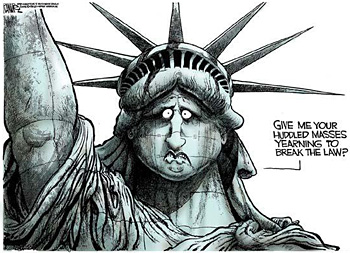 |
 |
 |
 Editorials | Issues | April 2007 Editorials | Issues | April 2007  
More Immigration, Less Crime?
 Domenico Maceri - PVNN Domenico Maceri - PVNN


| | A recent Harvard University study found the number of violent criminal acts among Mexican-Americans is much lower than that of other ethnic groups - including whites. |
“What part of illegal don’t you understand?” wrote a reader from Florida, commenting on one of my articles on immigration. The reader misunderstood my writing as supporting illegal actions and tried to correct me by saying that “illegal Mexicans are invading the U.S. and cause crimes, sell drugs, etc.”

The reader’s point of view is not unusual from that of the average American in so far as the link between crime and immigration. But is it really true that immigrants are causing crime to rise in the U.S.?

No, seems to be the answer of a number of scholars who have studied the issue in several major American cities. Ramiro Martinez, a professor of criminology at Florida International University, for instance, has analyzed homicide data in border cities such as San Diego, California and El Paso, Texas. These are areas with large numbers of residents of Mexican ancestry and immigrants. He found that homicide rates among Mexican residents of these cities are lower than those of other ethnic groups, including whites. Martinez has noted the same pattern in Haitian immigrant communities in the Miami area.

Andrew Karmen, another criminologist, studied the subject in New York City and discovered that young and poor immigrants between 1980 and 1990 had a positive influence in lowering crime in their neighborhoods. Chicago, another large city, has been the subject of study of Robert Sampson of Harvard University. Sampson found that the number of violent criminal acts among Mexican-Americans is much lower than that of other ethnic groups including whites.

When you think of crime you immediately think of lower class neighborhoods and poverty. Yet, in spite of their poverty, immigrants do not necessarily engage in more crimes than the average American. Of course, in poor neighborhoods the disorder, broken windows, garbage on the ground may give the impression of crimes. But that is not true, according to Sampson, since burglaries in immigrant neighborhoods in Chicago are very low.

Not everyone agrees with this idea that the increase of immigration, legal and not, reduces the crime rate. Wesley Skogan, a professor at Northwestern University in Chicago, says that the decrease in crimes has occurred not in immigrant neighborhoods but in areas where “community policing” has been the strongest.

This technique pushes law enforcement officers and community members to cooperate. In essence, residents become the eyes and ears of the police, allowing officers to act before crime occurs. Skogan says that in fact the crime rate has gone up in immigrant neighborhoods but that official data masks its true numbers. Immigrants, especially illegal ones, tend to stay away from police and do not report crimes for fear of being deported.

Crime in the US is in general going down and that is due according to many experts to community policing. But even if that is true it offers little reassurance to citizens who are easily influenced by TV images and newspapers headlines. The crime committed by an immigrant is magnified particularly if it’s done by an illegal immigrant who has already broken the law of entering the country illegally.

In spite of diverging opinions from scholars it makes sense that in immigrant neighborhoods the family has a strong influence, stronger than for the average American. Immigrants depend a lot more on other members of their families than social structures which are difficult for them to penetrate because of language and cultural problems but also because authorities are mistrusted.

It’s strange that one of the criticisms that is often thrown at immigrants is their slow assimilation into American culture. It happens though that crime rises with second and third generation residents. Apparently, immigrants manage to put up with treatment which their kids and grandkids find intolerable and thus react in ways that their ancestors would never dare.
 Domenico Maceri, PhD, UC Santa Barbara, teaches foreign languages at Allan Hancock College in Santa Maria, CA. He is the author of a book on Pirandello, one on Spanish grammar, and another on Italian grammar. He has also published a number of articles in newspapers and magazines around the world, some of which have won awards from the National Association of Hispanic Publications. Domenico Maceri, PhD, UC Santa Barbara, teaches foreign languages at Allan Hancock College in Santa Maria, CA. He is the author of a book on Pirandello, one on Spanish grammar, and another on Italian grammar. He has also published a number of articles in newspapers and magazines around the world, some of which have won awards from the National Association of Hispanic Publications.

Click HERE for more articles by Domenico Maceri. | 
 | |
 |



